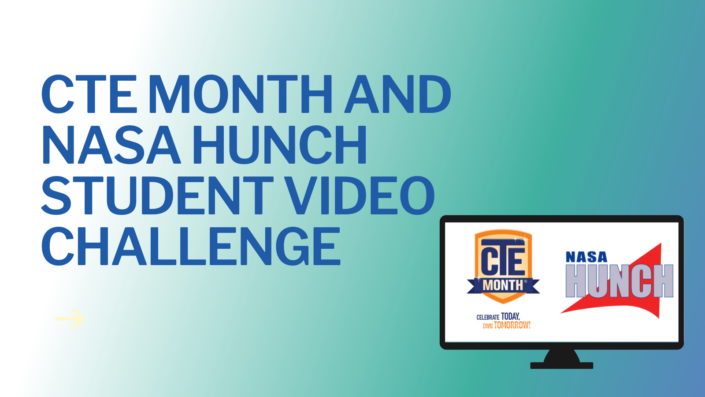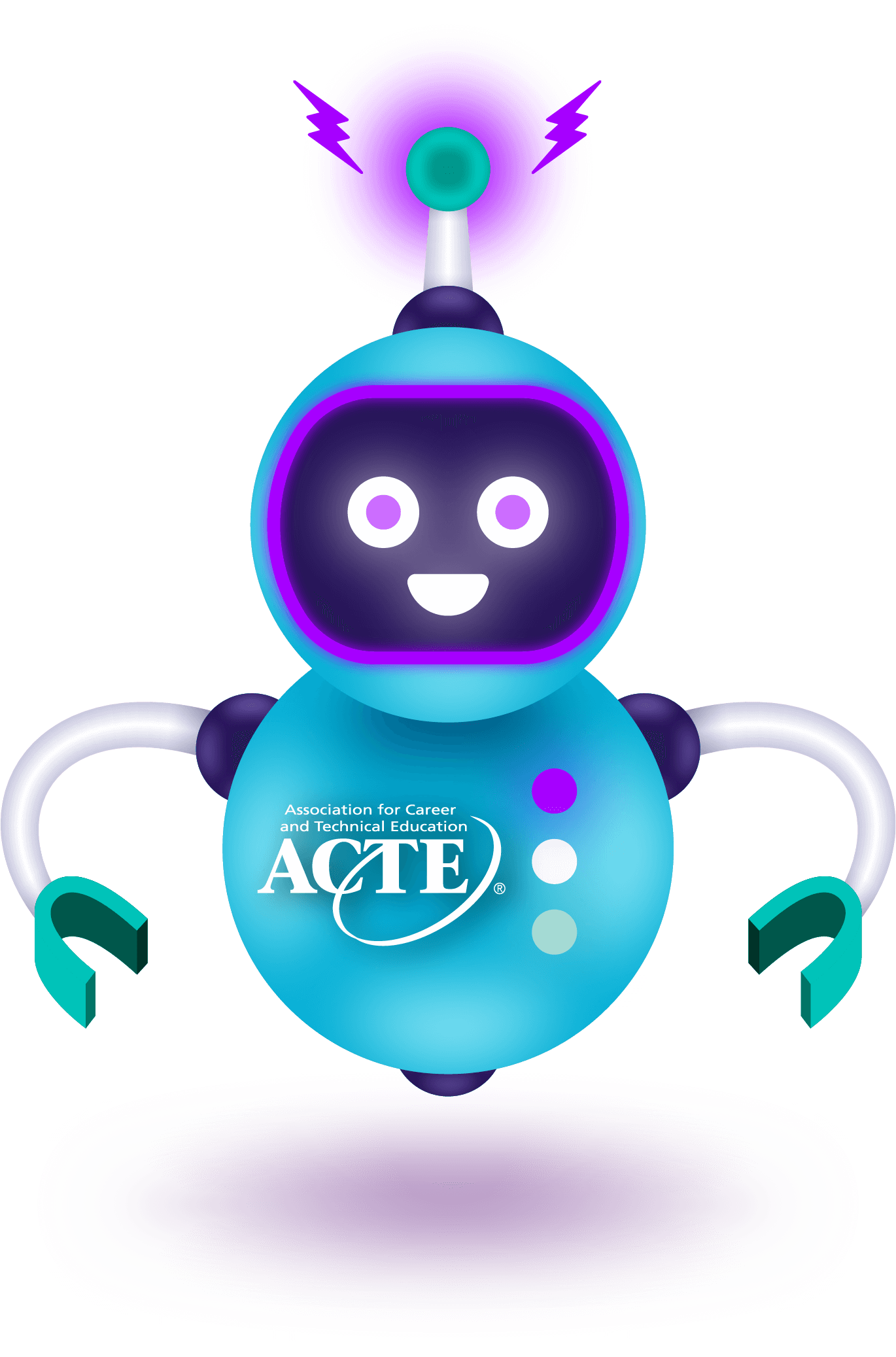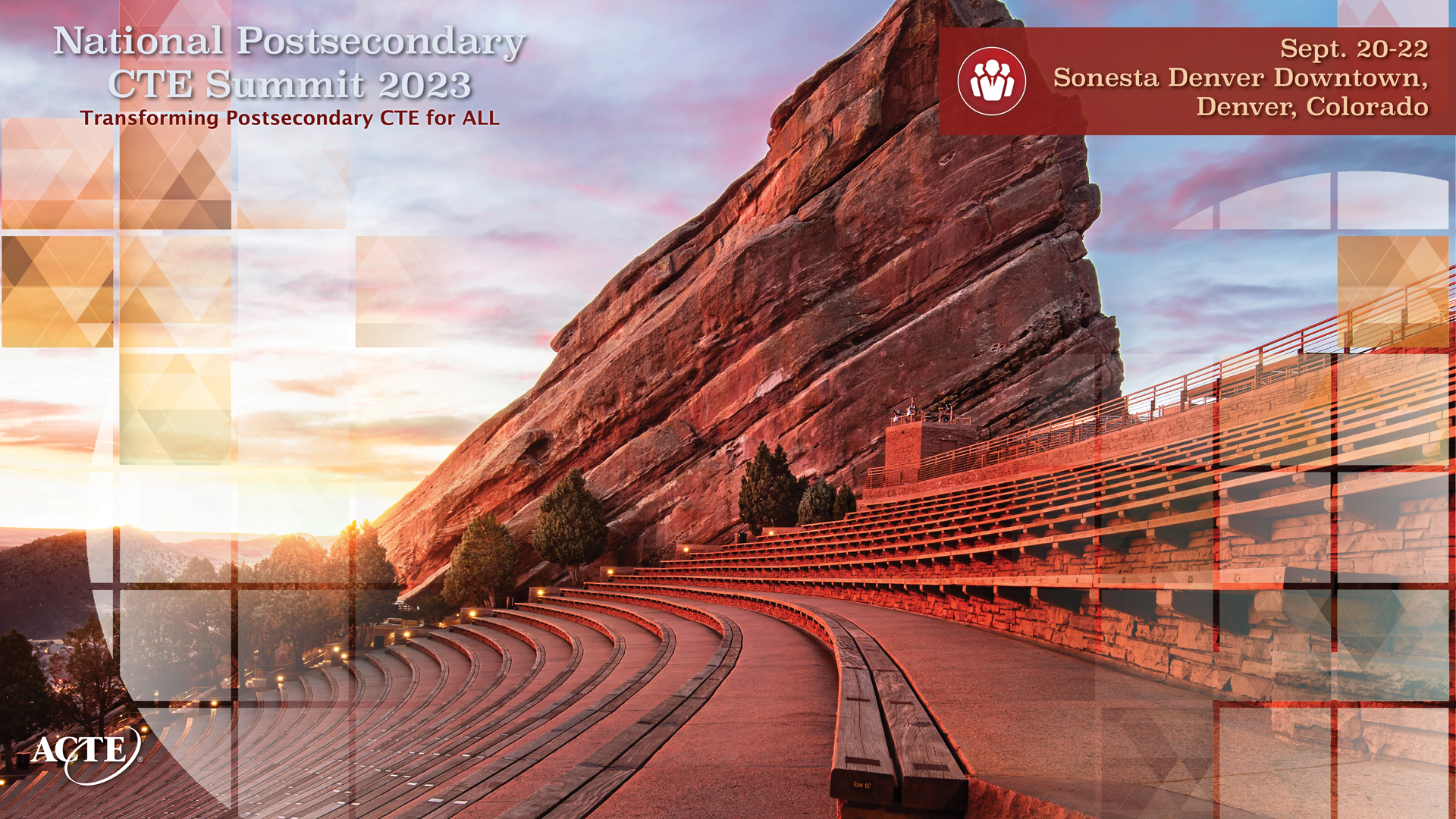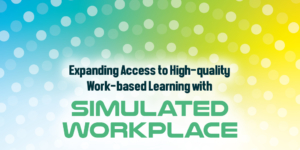Submit your story ideas for Techniques!
Category: Uncategorized
Influence CTE at NPS
 Attend NPS 2024! Influence CTE-related policy priorities at ACTE’s National Policy Seminar. With a featured event from the CTE Research Network!
Attend NPS 2024! Influence CTE-related policy priorities at ACTE’s National Policy Seminar. With a featured event from the CTE Research Network!
NPS 2024 happens March 17–20!
Voice your CTE needs to help shape education policy priorities; participate in visits with policymakers on Capitol Hill. Featured sessions will cover best practices for influencing federal policy and CTE advocacy and messaging. And on the last day of the event, March 20, the CTE Research Network will address expanding the evidence base for CTE.
Learn more and register today.
Why go to the moon?
The student video challenge returns! ACTE, host of CTE Month, and NASA HUNCH are excited to collaborate once again.
Announcing the 2023–24 student video challenge
The contest engages students to showcase CTE and project-based learning programs in high-demand career fields on Earth and in space. This year’s theme: “Why Go to the Moon?” Interested students should feature CTE pathways, courses, and careers of the future to fuel and cultivate NASA’s future missions.

Join the Postsecondary CTE Summit
Join us at ACTE’s Postsecondary CTE Summit, happening Sept. 20–22 in Denver, Colorado. Help ensure that our postsecondary CTE students are successful in their educational journeys and beyond!
- Address equity gaps
- Build partnerships
- Support educators
- Identify and develop resources
>nbsp;
Learn more and register today.
Influence policymakers at NPS
 Join CTE professionals from across the nation at ACTE’s National Policy Seminar (NPS) to voice your vision on key education policy topics.
Join CTE professionals from across the nation at ACTE’s National Policy Seminar (NPS) to voice your vision on key education policy topics.
Engage policymakers on key CTE issues
Attendees will also learn about best practices for influencing federal policy, related to CTE advocacy and messaging. NPS 2023 happens in Arlington, Virginia, March 19–22.
Learn more and register to attend.
“What is the purpose of NASA?”
The student video challenge returns! ACTE, host of CTE Month, and NASA HUNCH are excited to collaborate once again.
Enter the 2022–23 student video challenge!
The contest engages students to showcase CTE and project-based learning programs in high-demand career fields on Earth and in space. This year’s theme: “What Is the Purpose of NASA?” Interested students should feature CTE pathways, courses, and careers of the future to fuel and cultivate NASA’s future missions.

Join our book club
With the support of the Inclusion, Access, Equity and Diversity (IAED) Advisory Group, ACTE members and career and technical education (CTE) professionals engage in webinars exploring IAED in CTE. Join the think tank. These interactive sessions will challenge CTE educators to consider how they may best serve all students. And this spring, an all new book club event challenges educators to think critically.
How do we remove barriers to success in career and technical education (CTE)?
These interactive roundtable discussions (and the book club meeting) will focus on sharing practical examples and strategies for supporting variability in CTE. Webinar topics in this series have included caring for the professional growth and well-being of teachers, multilingual learners, students with disabilities, nontraditional learners and other protected populations. Two upcoming webinars, scheduled to take place on March 16, will focus on the following topics:
- Cultural Competence in Action: Multigenerational learners
- Supporting Teachers: Vicarious trauma

And then join the book club!
The last webinar, on April 20, will feature thought-provoking discussion on two books. We hope you consider participating in book club.
- Courageous Conversations About Race: A Field Guide for Achieving Equity in Education, by Glenn Singleton
- So You Want To Talk About Race, by Ijeoma Oluo
Learn more.
Improving educational outcomes with equity in mind
The February 2022 issue of Techniques seeks to address the unique challenges that diverse students face to success, or even entry, in high-wage, high-demand CTE pathways. Transportation, for example, is a “huge barrier,” wrote Amanda Bastoni, educational research scientist at CAST and ACTE’s new inclusion, access, equity and diversity (IAED) coordinator. “This is a huge barrier, especially in rural areas where public transportation is limited or nonexistent.”
CTE leaders dedicate copious time and resources to find solutions for their students. Consider the exceptional educators in Arizona’s west valley region who worked closely with the state licensing board to accommodate group certification testing. “This helped reduce students’ nervousness as they had their classmates attempting the test nearby,” wrote Shelly Thome (pp. 22–26), director of exceptional student services at West-MEC. “Further, reserved group seating for the licensing exam helped West-MEC arrange group transportation to and from the testing site with instructors accompanying students. “Access to testing sites is vital to credential attainment.”

Read Techniques in February 2022: The Equity Issue
Some issues of equity in education may be addressed with clear and tangible solutions, while others will require a steadfast commitment to change over time. “There still exists a negative perception of career and technical education among some Black families, who only want their students to pursue four-year degrees.” In her article, Anuli I. Phillips counsels educators on the need to “be versed in and knowledgeable of the cultural context with which Black students approach CTE. The special experiences — consequential of their racial construct assignment — cannot be minimized or ignored. Rather, assist in providing [students and students’ families] with tools to explore what meaning can be made from their previous experiences and notions.”
ACTE prioritizes the development of high-quality CTE programs of study for diverse audiences.
Further, the Association condemns institutional racism in all forms — standing up in the name of social justice and civil rights. We continue to conduct outreach and provide support for CTE professionals who express similar goals to advance the ideals of IAED, thus developing stronger, more equity-minded leaders in our fields. Will you consider getting involved?
We hope you enjoy Techniques in February 2022: The Equity Issue.
Expanding access to high-quality work-based learning with Simulated Workplace
“Expanding access to high-quality work-based learning with Simulated Workplace” appears in its entirety in Techniques’ November/December 2021 print issue.
“Great meeting today. Let’s discuss ideas for our engine challenge tomorrow morning, after our safety data updates. Thanks everyone for your attention.” Jake then gathered up the meeting’s paperwork and moved with confidence toward his company’s tool area to prepare for the day’s projects. You may wonder… What company does Jake work for? What is his position? Where is his company located? What engines do they produce?’
Jake is a secondary student of career and technical education (CTE).
Many students like Jake engage in job roles with real systems of accountability in authentic workplace environments, all while still enrolled in public education. This innovative approach to education, Simulated Workplace, has served students across the nation and internationally since its founding in 2013 by Kathy J. D’Antoni, former assistant superintendent for technical and adult education at the West Virginia Department of Education.
The Strengthening Career and Technical Education for the 21st Century Act, known as Perkins V, expects that work-based learning (WBL) will be incorporated as part of all students’ career pathway programs. However, ensuring equitable access to high-quality WBL opportunities can be difficult for many CTE educators, especially those in communities who face geographic, economic, social and/or cultural barriers to access. West Virginia’s preponderance of rural schools made statewide access to WBL particularly challenging, but it also presented a call for innovation.
Simulated Workplace was created to design environments in which all CTE students can learn about workplace cultures, parameters and practices.
Simulated Workplace seeks to transform CTE classrooms or labs into high-quality business and industry learing environments. The model creates opportunities for students to work in real school-based businesses to solve problems, set goals, collaborate, manage workplace challenges, and communicate in teams while developing technical and academic skills and knowledge. CTE classrooms or labs become job sites in which students take on safety management, quality assurance, human resources and more. Students apply to a program — otherwise known as a com- pany — and receive guidance from local business and industry partners as well as their teacher, who often acts as the company’s CEO.
Twelve essential protocols structure the work:
- Student-led Companies
- Application and Interview Structure
- Formal Attendance System
- Drug-free Work Zones
- 6S Environment
- Safe Work Areas
- Workplace Teams
- Project-based Learning (PBL) and Student Engagement
- Company Name and Handbook
- Company Meetings
- On-site Business Review
- Accountability
How does the Simulated Workplace expand access to WBL?
In Simulated Workplace environments, students take responsibility for their own learning. Students apply and interview for relevant positions, a process through which they gain firsthand experience of human resources procedures. They also benefit from practice pitching themselves to an employer. As CEOs, CTE teachers often rotate students through jobs, using the application and interview process to facilitate learning. Students may experience what it’s like to be fired and rehired for various jobs or roles — which can help them better understand workplace expectations and the responsibilities that come with authority.
Protocols for project-based learning, teamwork, company meetings and an emphasis on organizing for productivity using lean manufacturing methodologies help bring additional relevance to Simulated Workplace classrooms. Workplace attendance, project completion, and industry credentials and certifications are used to measure employees’ success.
Company safety standards are upheld by student safety managers. They are responsible for ensuring their workspaces follow Occupational Safety and Health Administration or other industry-recognized safety guidelines. Simulated Workplace projects may occur across various shifts of employees, giving students opportunities to solve communication and project management challenges.
This structure allows fewer business leaders to serve larger numbers of students — a boon in rural or industry-sparse communities.

How can I implement Simulated Workplace?
The Southern Regional Education Board (SREB) collaborated with state, district and local leaders to develop Simulated Workplace initiatives nationwide. Most teachers find it challenging to shift from providing direct instruction to facilitating a company in their classrooms or labs. SREB consultants offer professional development and coaching that helps teachers phase in the 12 protocols over time. We’ve learned three critical lessons about what it takes to successfully make this cultural shift:
Project-based instruction is key.
SREB begins by helping teachers learn and use industry-appropriate problem-solving processes as they gradually make the shift to authentic project- and problem-based learning. We recommend phasing in PBL over a three-year period of ongoing professional learning.
On-site inspections generate valuable feedback, not only for the teachers and students who run Simulated Work- place companies, but also for state, district and school leaders.
In Alabama, SREB modified West Virginia’s business and industry inspection instrument and developed a separate walk- through inspection instrument for teachers and school leaders to use. Instruments like these can help states, districts and schools gather the data they need to design effective professional development on the creation and maintenance of Simulated Workplaces.
Existing CTE advisory committee members make great business and industry advisors.
SREB has helped schools and tech centers better engage their advisory committees in actively supporting Simulated Workplace.
Make Simulated Workplace work for your students.
Let’s go back to Jake. He runs company meetings at which he takes accountability for his own, his colleagues’ and his company’s success. Jake has held several positions within his company that will help guide him in the future. Simulated Workplace provides a way for more students like Jake to gain workplace skills and experiences. Simulated Workplace offers a great tool for increasing access to quality work-based learning opportunities in any school.
Linda Floyd, Ed.D, is program director of Technology Centers That Work at the Southern Regional Education Board.
Kathleen McNally, Ph.D., is a senior school improvement instructional coach at SREB.
Read the full article in Techniques in print in November/December.
Techniques presents the Access Issue
“ACTE strives to empower educators to deliver high-quality career and technical education (CTE) programs that ensure all students are positioned for career success.”
In order to provide high-quality CTE programs, we must make sure students have access. A great many students face barriers that may prevent them from accessing career and technical education. As CTE educators, we must do everything possible to remove these barriers to enable our students to accomplish real-world goals.
The Access Issue of Techniques will provide theoretical and practical knowledge. Our authors — alongside ACTE staff and the board of directors — share a passion to provide opportunities for students.
- Access enhanced work-based learning (WBL) experiences
- Participate in career and technical student organizations
- Benefit from articulated credit arrangements
All students deserve access to high-quality CTE programs of study. And all students may be afforded these opportunities using innovations such as Simulated Workplace for WBL. In the last issue of Techniques, we focused on inclusion. As we strive to make our classrooms and learning environments more inclusive, we must also see to it that diverse student groups all may access career options aligned to their interests, skills and aptitudes. America is the land of dreams and opportunity. As the population of foreign-born students continues to increase, we must provide access to the American dream. ACTE is here to support you as we build a greater workforce for all.
Enjoy the Access Issue.
For a limited time, members and nonmembers alike may read the full digital issue. Further, readers may enjoy a selection of articles published in Techniques online throughout November and December. We hope to see you at ACTE’s CareerTech VISION 2021 — whether in person in New Orleans, Louisiana, or virtually from your work site. And one last thing! Make sure to check out the board of directors’ candidate bios; ACTE members, plan to vote for your leaders!
Together, we partner as champions of access for our students.
What does access mean to you? Let us know. Contact Lia Milgram, Techniques managing editor, with questions, comments, concerns or compliments about the Access Issue.















